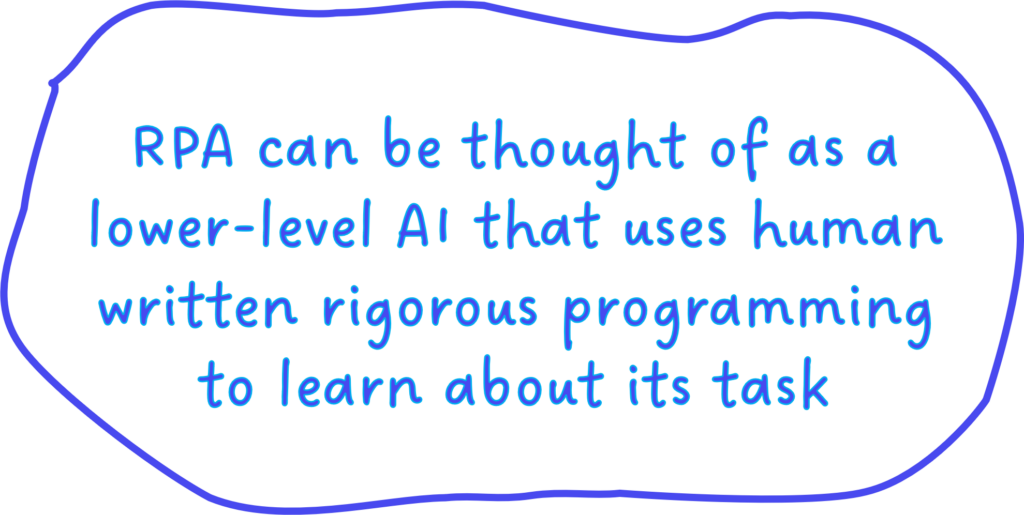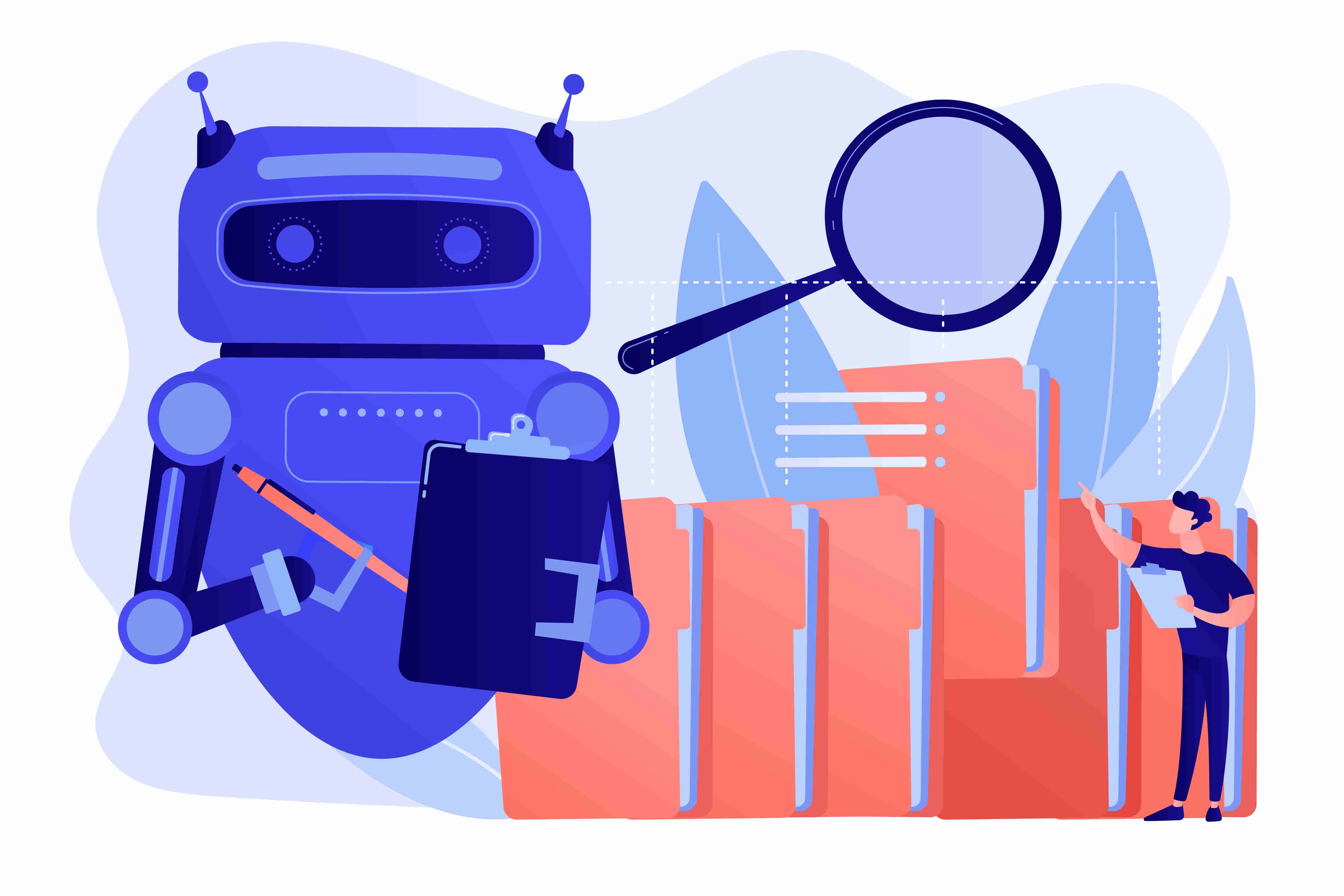Robotic Process Automation (RPA) and Artificial Intelligence (AI) are two automation technologies that help organizations to perform business tasks using softwares and machines. The two differ in the complexity of ‘intelligence simulation’ – RPA simulates intelligence with basic coding while AI uses advanced methods such as statistical modeling and neural networks to make machines intelligent.
This article presents a comprehensive guide of RPA and AI. It looks at the individual definitions, key differences, and combined benefits in the business process automation landscape.
Table of Contents
- What is RPA?
- What is AI?
- Difference between RPA and AI
- Benefits of RPA combined with AI
- Why is automation important for business?
- Video Lecture
What is RPA?
Robotic Process Automation is a software technology that trains and uses robots for routine, repetitive, and predictable tasks. It allows humans to write instructions to build, deploy, and manage software robots that could perform interactions in place of them.
These software “robots” (also called bots) are powered inside a machine. A bot can be made capable of mimicking human-machine interactions which they perform non-stop, absolutely error-free and more quickly than humans. The human-machine interactions include: reading computer screens, using keystrokes, identifying and extracting data, and performing other rule-based processes.
RPA has found its applications in Business Process Automation (also termed as Hyperautomation) to automate daily mundane and repetitive business tasks allowing robots to complete them in a fast and accurate manner.
There are two kinds of RPA.
Attended: In attended RPA, a human is present alongside a robot and is responsible for performing critical tasks, while the robot performs only the repetitive and predictable tasks.
As an example, a customer service representative (CRO) can assign complaints with pre-determined tasks to a bot and deal with intelligent complaints themselves.
Unattended: In unattended RPA, a process is fully automated and performed holistically by the robot. There’s no human interaction required alongside the robot.
An example of unattended bot is in Data Extraction. By nature data extraction is a rules-based business process where data could be easily read by the bot and stored in a file without needing a human to supervise the process.
Learn more about RPA in an article series by Red Hat.
What is AI?
Artificial intelligence is the science and engineering of making machines intelligent. The word ‘Intelligent’ here refers to the problem-solving and decision making capabilities of humans. This essentially means writing programs that enable machines to mimic human behavior with or without needing to manually program everything, states Harvard Business Review Analytics.
In AI, the robots may be physical or software depending on their use case. A software robot is an AI program that runs on a computer; example includes an image classifier, whereas a hardware robot could use AI to assist in intelligent tasks such as responding to human queries, or learning to walk, jump, and run across various scenarios.
Read about how MIT’s robotic Cheetah uses intelligence to run across a variety of terrains.

Advance AI uses human engineered models (such as in model-based machine learning) that are pre-trained on known tasks and then extract features from unknown data to reach a decision. Or it uses a model free neural network approach (such as in deep learning) self-learning things without needing a human to engineer a model.
Examples of AI-powered machine capabilities include: Natural Language Processing- NLP; enabling machines to read and understand text information, and Computer Vision- CV; enabling machines to understand visual information such as images and videos.
Intelligence of robots can come in handy in Business Process Automation (or hyperautomation). The ability of robots to learn across various unpredictable scenarios can help businesses solve problems without needing human assistance.
For example, a company sets an AI program that extracts information from web registration forms. If on a future day, a field of information changes, the AI robot would identify and understand this change and (as per the function of the robot) may create a new category so as not to cause error in existing data.
Difference between RPA and AI
Within the industry of hyperautomation, there’s a disagreement as to whether RPA and AI are similar or not. For example, in Harvard’s Business Review Analytics – Executive’s Guide to Real World AI, it reaches to a point saying RPA does qualify as AI; given the definition they use for AI which includes the rules based, highly programmable logic as a form of intelligence.

Theoretically speaking, RPA can be thought of as a lower level AI that uses human written rigorous programming to learn about its task. The written programs, based on business logic, make the RPA systems intelligent.
If you ask industry experts, they will tell you that RPA and AI are different systems where the former don’t demonstrate the “intelligence” just as the latter’s deep neural networks can. And they are not wrong about it. The difference in RPA and AI mainly comes in the ability of advance AI such as machine learning, and deep learning to accomplish tasks which it was not taught about and making predictions about future events.
Whether RPA and AI are similar or not, a more important question to consider is: What opportunities could be created if both go hand in hand?
The benefits of RPA combined with AI
The powerful AI technologies such as deep neural networks are increasingly finding their way in the RPA toolbox. RPA tools can use this “self-learning” AI technology to boost language and visual processing.
“The decision making ability of RPA-AI enabled bots can offer advantages of automation, accuracy, and efficiency in accomplishing business tasks”
As an example, an RPA bot, combined with an NLP algorithm, could be made to interpret and understand information in a document that it’s tasked to process. Using advance AI intelligence it can utilize the information and then take the next steps as determined by the bot.
Why is automation important in business?
Some recent survey data from Ui path shows that Business Process Automation has offered organizations tremendous advantages. These include: improved work precision and process efficiency, greater resilience (from the use of bots), better work quality, and cost reduction.
Additionally, business process automation also leads to better data utilization for business analytics. Automated data engineering pipelines offers organizations to save time and effort in the rigmarole and focus more on data analytics outcomes and business strategy formation.
This leads us to conclude another benefit, that human resources can now focus more on strategic work thereby participating in more productive tasks.
Another survey result shows that having to get rid of routine banal tasks and towards more creative tasks has improved employee job satisfaction.
Video Lecture
Using the platform of Dice Analytics, recently Muhammad Neman – Director IT at SkyElectric Ltd., has given a free seminar on Getting Started with Robotic Process Automation. Visit the Zoom session to find more about Hyperautomation, RPA vs. AI and Hyperautomation, RPA examples, and RPA tools such as Microsoft Power Automate.
The video is available at LinkedIn as a previously live lecture.




